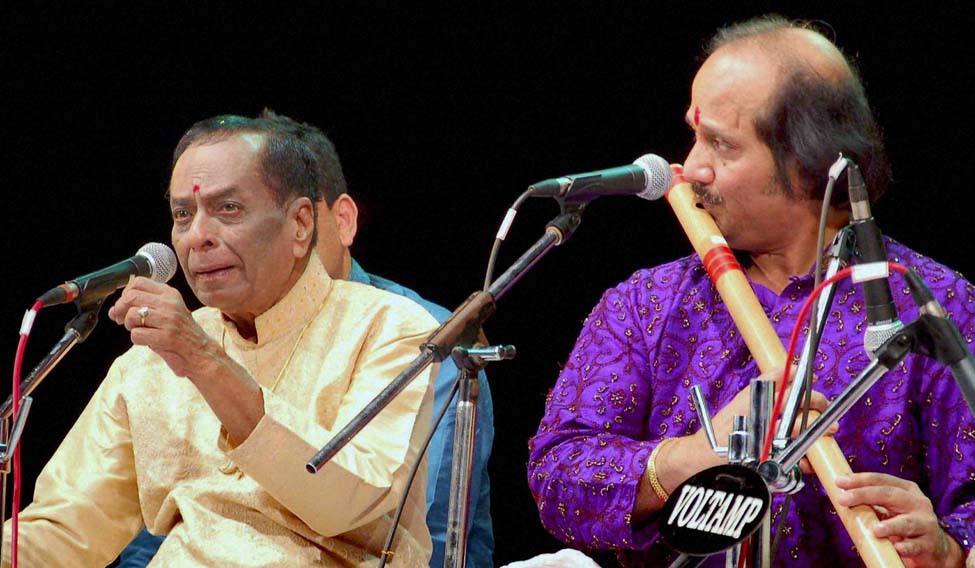A cursory look at the schedule of any music sabha in Chennai makes it obvious that the ‘music season’ is hardly instrumental musician-friendly. At the Music Academy, arguably the season ‘bellwether’ for their primetime slot 06.45pm, only 4 out of 16 are ‘instrumental’ concerts; overall, in the 80 concerts, only 13 are instrumental (one nadaswaram). The question is: do audience, during the season, prefer vocal concerts over instrumental music?
“In general, that appears to be the trend,” says ‘Keyboard Sathya’, the 22-year-old wizard. In his case it is even more complicated, as the instrument he plays is not even considered for performance at the Music Academy during the season. Purists believe that an instrument like the keyboard can never produce gamakkas (microtones). Clearly they have not attended any of his concerts! But then, this is hardly a new development. The All India Radio (AIR) had banned the use of harmonium for nearly four decades in their studios.
Says young Veena artist Baradwaj Raman, who is also the inventor of the portable veena (patent pending), “during the season it might be low, but the season indeed provides us an opportunity to be spotted. I have invitations to concerts outside the city because the organisers saw my video online. It is all about creating the opportunities.”
The 117th edition of the Parthasarathy Swami Sabha started with a nadaswaram concert by Thirumeignanam Brothers. While the attendance was initially lean, over the next hour the crowd swarmed in. Speaking at the inaugural session of the 91st Annual Music Conference, music maestro Ilayaraja said that “when words become silent, music speaks”.
Things were not much different even at the Nadaswaram concert at the Music Academy’s morning concert session (super senior slot). The first one of the season began with the concert of nadaswaram exponent Vysarpadi Kothandraman, a free concert open to all. It did not exactly have any on their balcony, thanks be to the famed unsaid ‘rotation policy’ of the academy, we can be certain that around the next masi-maham (about 12 years) we will be able to see this artist again. Just like in the case of Injikudi Subramanian, another nadaswaram maestro who holds the record of being the only nadaswaram artist to have played during the opening concert at the Salzburg Music Festival.
Speaking on the sparse audience for nadaswaram concerts, “The practice of relegating Nadaswaram to a mere mangala isai format is the principle reason,” says music connoisseur and journalist B. Kolappan. Nadaswaram, in general, faced the complaint of being too loud. "The concerts were originally designed for open spaces and it did not fit in the scheme of things with the city sabhas," he said.
However, Injikudi rewrote the equation, presenting it in a format meant for the ‘chamber environment’; low on decibel and high on aesthetics. He used the mridangam and violin as accompaniments, rather than the thavil.
The 'nadaswaram bani', referring to the aesthetic technique followed by the greats of yester-years, be it GNB or Semmangudi, involved displaying the akarams and resulted in an experience for the listener in the form of a cascading flow along with the ‘karvai’ (standing notes)”, says Sangita Kalanidhi Sanjay Subrahmanyan.
"There is a need to understand the difference between ‘mangala isai’ and the concert format. In fact, in the past, a separate stage used to be put out, right at the entry of academy (lobby) and the mangala isai on the inaugural day used to happen there. But, at the same time, the full fledged nadaswaram concerts would be organized at the main concert hall, with artists like Thiruvizha Jaishankar or Sembanarkovil. These were always treated as two separate formats," Sanjay added.
"The challenge for the organisers is in the seamless integration of nadaswaram concerts with their regular schedule."
Speaking on this topic of nadaswaram artists, renowned Carnatic musician T.M. Krishna said, "the whole Carnatic music owes this idea of taking any line of music, Solkattu, and developing it on an intellectual and emotional construct. This is largely due to the contribution of nadaswaram and thavil vidwans, and it is from this canvas that most present day Carnatic vocal musicians have built on. Therefore, the need is to first acknowledge it and recognise there is a problem out there when it comes to the audience for instrumental and nadaswaram concerts. The urgent need is to rekindle the art of listening the nadaswaram and popularise the art form”.
Disclaimer: The opinions expressed are the author's own and need not reflect that of the organisation






